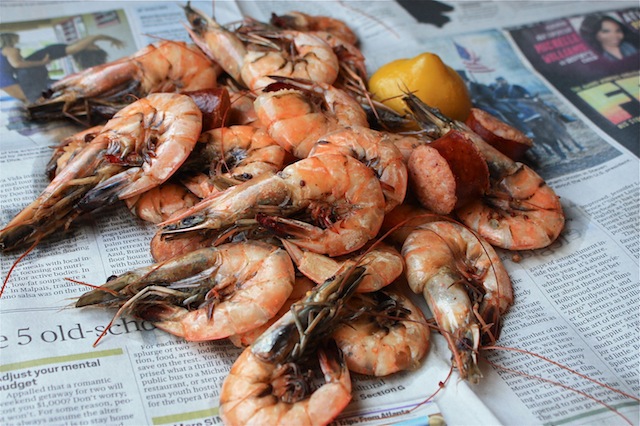
Boiled Shrimp
A seafood boil is a culinary tradition we carry out every chance we get. It’s a casual outdoor cooking event where we boil mass quantities of fresh seafood, sausage and vegetables in huge pots of highly seasoned water. When the cooking’s done, we usually spread everything out on a large table lined with newspaper and invite everyone to roll up their sleeves, grab a cold beer and dig in. We plan seafood boils for everything from christenings and birthdays to graduations and wedding rehearsal dinners. We also have boils to celebrate holidays and cheer on our Saints and LSU Tigers. Actually, we have boils anytime crawfish, crabs or shrimp are running good. It’s one of the cornerstones of our culture and something we proudly and passionately share with others.
To carry out one of these backyard feasts, most of us rely on some pretty impressive equipment. We’re talking pots the size of small watercraft (okay, that may be a stretch but 80- to 120-quart pots are not) with huge basket inserts, high-pressure propane burners that can easily be mistaken for jet engines by those who can hear but not see them and oversized tools like wooden paddles capable of not only stirring the pot but also propelling mighty pirogues down the bayou–mere grocery store finds in South Louisiana. However, since most people who live “beyond the boot” do not have or care to invest in these types of industrial toys, Larry and I have been working really hard at scaling down our recipes and modifying the how-to’s for the stovetop. The first one up is Boiled Shrimp.
All that’s needed to pull off a mini-shrimp boil is a 10- or 12-quart stock pot, a large slotted spoon or small mesh colander with a handle and the courage to take your seasonings where they’ve never gone before. Really, you need to add a lot of salt and spices to the water in order for the seasonings to penetrate the shrimp shells and flavor the meat. Even though it may seem like a lot on paper, it’s not. And you control the heat level by the amount of time you allow the shrimp to soak–all that’s spelled out in the instructions.
When it comes to preventing the shells from sticking to the shrimp, I have one piece of advice–don’t overcook them. Some people swear by adding butter or vinegar to the water to avoid this mishap. Others claim the key is to not salt the shrimp until after they are cooked. I’ve never bought into any of that and nine times out of ten my shrimp turn out perfect. When they don’t, it’s because I got distracted and overcooked them.
As for the add-ins or extras, my recipe includes the citywide standards–new potatoes, corn on the cob, pork sausage and mushrooms. But over the years I’ve thrown in artichokes, okra, Brussels sprouts, carrots, pineapple, sweet potatoes, tortellini, hot dogs and even turkey necks. Dig through your fridge, and see what’ve you got. Everything but the kitchen sink is welcome.
Boiled Shrimp Recipe
6 quarts cold water
2 lemons, halved
2 large onions, unpeeled and halved
1 head of garlic, sliced in half crosswise
1 4-ounce bottle Zatarain’s Concentrated Shrimp & Crab Boil seasoning
1 3-ounce bag Zatarain’s Crawfish, Shrimp & Crab Boil seasoning
4 bay leaves
1 26-ounce container salt
1/4 cup black pepper
1/4 cup cayenne pepper
3-4 pounds fresh medium or large Louisiana shrimp, head-on and unpeeled
4 cups ice
1 pound new potatoes (small red potatoes)
4 ears fresh corn, shucked and cut in half
1 pound smoked pork sausage, sliced
1 8-ounce package white button mushroom
Fill a large pot with the water leaving plenty of room for the seasonings and shrimp (a 10-quart pot is perfect); bring to a boil. Turn range hood on high (the air’s about to get spicy). Squeeze the lemon juice into the water and add lemon halves, onions, garlic, shrimp & crab boil seasonings, bay leaves, salt and peppers; boil for 10 minutes to allow flavors to develop. Add shrimp. The water will stop boiling at this point, which brings us to the tricky part. If you were boiling the seafood outside over a high pressure burner, I would instruct you to bring the water back to a boil (which happens quickly) and cook the shrimp for 1-2 minutes (large shrimp may take a little longer). However, on the stovetop, quite often the shrimp are done before the water returns to a boil. To avoid overcooking them, keep the heat on high and stir the shrimp frequently. The shrimp are done when they turn pink and the meat begins to pull away from the shell (this is most obvious where the tail meets the head). When they reach this point, turn off the heat. Add the ice to stop the cooking process and help submerge the shrimp in the liquid to absorb the seasoning. Using the back of a large spoon, push down any shrimp that float to the top. Let the shrimp soak uncovered for 10 to 45 minutes, depending on how spicy you want them. Sample a shrimp every 5 minutes during the soaking period until they suit your taste. Using a slotted spoon or small mesh colander with a handle, transfer the shrimp to a large platter. Return seasoned water to a boil. Add potatoes and cook for 10 minutes. Add corn, sausage and mushrooms and continue cooking until potatoes are fork-tender, about 10 minutes more. Drain vegetables and sausage and serve hot with shrimp. Makes 6-8 servings.
Genêt



